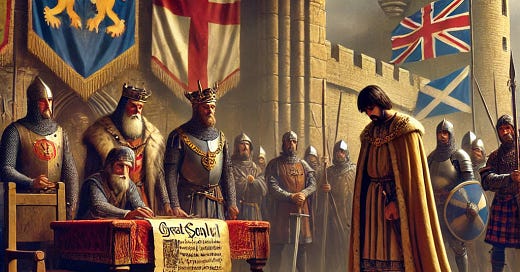Was the Great Seal of Scotland Really Destroyed in Brechin?
The history of Scotland is full of dramatic moments, political betrayals, and symbols of sovereignty that have been fought over for centuries. Among these, the Great Seal of Scotland holds a special place. Used to authenticate official documents of the Scottish monarchy, its destruction would have been a moment of enormous significance.
One of the most intriguing claims in Scottish history is that the Great Seal of Scotland was deliberately broken into pieces in Brechin in 1296, following the surrender of King John Balliol to Edward I of England. But is there any truth to this story, or is it one of the many myths that have woven themselves into the fabric of Scotland’s past?
The Great Seal of Scotland: A Symbol of Sovereignty
The Great Seal of Scotland was not just a piece of wax stamped on parchment—it was a powerful emblem of royal authority. Every important document issued in the name of the Scottish monarch bore its imprint, making it essential for governance. To possess the seal was to hold the very legitimacy of the kingdom in one’s hands.
Seals were often custom-made for each king, depicting the reigning monarch on horseback on one side and enthroned on the other. Balliol’s Great Seal was no exception, representing him as the rightful ruler of Scotland. But in 1296, his kingship came to a humiliating end, and with it, the fate of his seal was sealed—perhaps quite literally.
The Surrender at Brechin: Humiliation and Consequences
In July 1296, King John Balliol was forced to surrender to Edward I of England after the disastrous Scottish defeat at the Battle of Dunbar. Following this, Edward moved north, and on July 10, 1296, the official surrender of Scotland’s ruling authority took place at Brechin Castle.
Balliol, dressed in sackcloth as a sign of submission, formally renounced his throne in the presence of Edward’s representatives. This event became known as the “Toom Tabard” (Empty Coat) submission, symbolizing that Scotland was left without a true ruler. As part of this submission, the Great Seal of Scotland was reportedly broken to signify the end of Balliol’s rule.
The breaking of the seal was an immensely symbolic act—one that visually and physically demonstrated that Scotland, as an independent kingdom, had been dismantled.
Did Edward I Destroy the Seal—or Preserve It?
While the destruction of the seal in Brechin is a widely told tale, some historians argue that it may not have been destroyed at all. Edward I was notorious for collecting symbols of conquest, from the Stone of Destiny to important Scottish records and relics.
Alternative Theories suggest that rather than being shattered in Brechin, the Great Seal may have been seized and taken to England, much like other Scottish artifacts.
Historical Records from 1296 indicate that Edward confiscated Scotland’s royal and legal documents, removing them to Westminster, where they were later used to justify England’s dominion over Scotland.
If Edward indeed took the seal rather than destroying it, it may have been held as a trophy, much like the Stone of Destiny, which was not returned to Scotland until 1996.
Why Was Brechin the Site of the Seal’s Supposed Destruction?
Brechin Castle was a stronghold of Scottish resistance but ultimately fell under English control during Edward’s invasion. It is possible that because the official surrender took place there, the story of the broken seal became intertwined with Brechin’s history, even if the seal itself was never destroyed there.
Additionally, medieval chroniclers often embellished stories for dramatic effect. The destruction of a royal seal would have been a powerful image, reinforcing the idea that Scotland had been politically crushed.
What Happened to Balliol After the Surrender?
John Balliol, once the king of Scotland, was stripped of his title and exiled. He was imprisoned in the Tower of London before being allowed to retire in France. Though some Scottish nobles still supported him, his authority was forever broken—just like the seal that bore his name.
Conclusion: Truth or Legend?
The idea that the Great Seal of Scotland was broken in Brechin serves as a potent symbol of Scotland’s subjugation under English rule. Whether or not it was physically shattered, the impact of the 1296 surrender was profound.
If the seal was destroyed, it marked the official end of Balliol’s reign.
If it was taken by Edward I, it may have been used as a political tool, much like other Scottish artifacts that were looted and displayed as trophies.
In either case, the story of Brechin and the Great Seal remains one of the most compelling moments in Scotland’s long and turbulent history.
Final Thought: Could the Seal Still Exist?
Given that many historical Scottish documents taken by Edward I have never been recovered, it is tempting to wonder—could the Great Seal of John Balliol still exist somewhere in England, hidden in an archive or private collection? Until solid evidence emerges, the mystery of the Great Seal of Scotland remains unsolved.





